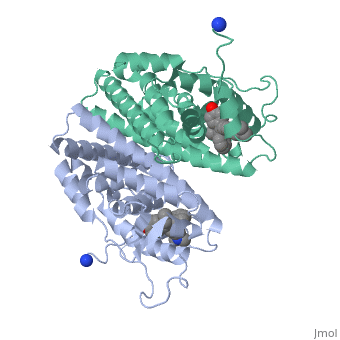Tamoxifen
From Proteopedia
(Difference between revisions)
| Line 1: | Line 1: | ||
| - | <StructureSection load='3ert' size=' | + | <StructureSection load='3ert' size='450' side='' caption='Estrogen Receptor Ligand-Binding Domain in Complex with 4-Hydroxytamoxifen (PDB code [[3ert]])'> |
| - | [[Image:tam.png|thumb| | + | [[Image:tam.png|thumb|250px|left|Prodrug Tamoxifen]] |
__TOC__ | __TOC__ | ||
Recent studies have shown that men and women with high estrogen levels, coupled with an already high risk of developing breast [[cancer]], are at a higher risk of the disease occurring.<ref name="danielle">Skafar, D., and S. Koide. "Understanding the Human Estrogen Receptor-alpha Using Targeted Mutagenesis." Molecular and Cellular Endocrinology 246.1-2 (2006): 83-90. </ref> Estrogen is necessary in many areas of the body. It gives cells permission to grow, including cancer cells. Estrogen is regulated through an activated estrogen receptor transcription factor. These transcription factors in the higher risk patients can activate oncogenes that accelerate cancer cell growth. A recent hypothesis suggests that a new way to prevent and treat breast cancer is to change the way estrogen binds to the receptor. The [[Pharmaceutical Drugs|drug]] Tamoxifen acts as a competitive inhibitor of estrogen and the [[Estrogen receptor]]. Those with a higher risk of breast cancer who undergo treatment with Tamoxifen show low breast tissue density, which suggests a lower breast cancer risk. Tamoxifen is a smaller molecule that mimics the shape of estrogen, allowing it to bind tightly to the estrogen receptor. | Recent studies have shown that men and women with high estrogen levels, coupled with an already high risk of developing breast [[cancer]], are at a higher risk of the disease occurring.<ref name="danielle">Skafar, D., and S. Koide. "Understanding the Human Estrogen Receptor-alpha Using Targeted Mutagenesis." Molecular and Cellular Endocrinology 246.1-2 (2006): 83-90. </ref> Estrogen is necessary in many areas of the body. It gives cells permission to grow, including cancer cells. Estrogen is regulated through an activated estrogen receptor transcription factor. These transcription factors in the higher risk patients can activate oncogenes that accelerate cancer cell growth. A recent hypothesis suggests that a new way to prevent and treat breast cancer is to change the way estrogen binds to the receptor. The [[Pharmaceutical Drugs|drug]] Tamoxifen acts as a competitive inhibitor of estrogen and the [[Estrogen receptor]]. Those with a higher risk of breast cancer who undergo treatment with Tamoxifen show low breast tissue density, which suggests a lower breast cancer risk. Tamoxifen is a smaller molecule that mimics the shape of estrogen, allowing it to bind tightly to the estrogen receptor. | ||
Revision as of 17:14, 16 January 2017
| |||||||||||
- ↑ 1.0 1.1 1.2 Skafar, D., and S. Koide. "Understanding the Human Estrogen Receptor-alpha Using Targeted Mutagenesis." Molecular and Cellular Endocrinology 246.1-2 (2006): 83-90.
- ↑ Pecorak, Sara, and Tom Susman. "Tamoxifen, Diethylstilbesterol and the Estrogen Receptor Ligand Binding Region." (04). Web. <http://biology.kenyon.edu/BMB/Chime2/2001/estrogen/FRAMES/start.htm>.
Proteopedia Page Contributors and Editors (what is this?)
David Canner, Michal Harel, Andrea Danielle Merr, Joel L. Sussman, Alexander Berchansky


